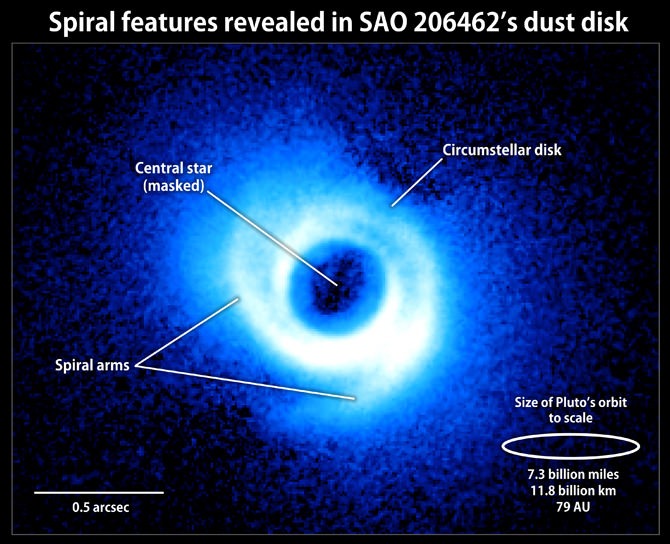Astronomers have known for some time that a star named SAO 206462 has a disk surrounding it, and have studied it with all available techniques including with Hubble chronographic imagery. But new high contrast observations with the Subaru Telescope has shown a surprising double-spiral feature in the disk, which may point to planets in the act of forming. Spiral waves are propagating through the disk, which astronomers think come from objects creating perturbations. Carol Grady, an astronomer based at NASA’s Goddard Space Flight Center said disks are the birthplace of planets, and astronomers know there should be a perturbation in the disk pointing to where a planet is located. “We thought we might find a wide gap, instead we were surprised to find a double spiral feature around the star in addition to the outer disk.”
[/caption]
The view was made possible by the High Contrast Instrument for the Subaru Next Generation Adaptive Optics, or (HiCIAO), which is designed to block out harsh direct starlight.
This new video, above, from Science@NASA provides more information, but in a teleconference from the Signposts of Planets meeting in October, Grady said all indications from their observation and from models is that are there are two large planets in this disk.
“The interesting part is when you form Jovian mass planets, they open gaps and channel materiel towards themselves,” she said. “We found two arms with a different pitch, so we think there are two planets.”
The planets have not yet been detected because the disk is extremely bright and planets might be at young ages. But Grady said astronomers should be able to follow the object over time, and as imaging techniques improve, they hope to one day take direct images of the planets.
“These spiral features are like a flashing neon sign that says look here for the good stuff!” Grady said.
See this NASA article for more information.


Another great and interesting findings from Subaru! Looks like it’s making up for time lost during coolant leakage incident 😉
Some details of SAO 206462 (HD 135344B): 8.7-magnitude, F4Ve ~8-17 Myr pre-main-sequence star (Herbig F star) located ~140pc (~450ly) away in the constellation Lupus. It is also a binary star with companion star SAO 206463 (HD 135344A) separated ~3000AU.
Have any studies been done on this star to ferret out possible orbiting planetary masses? None that I can find… yet.
More: http://articles.adsabs.harvard.edu//full/1995MNRAS.274..977C/0000984.000.html
I don’t know. If the postulated planet’s mass is great enough, an eventual star wobble may show up over time. Anyway, when I saw the picture of the star with a spiral structure, I thought of what you said on another post about “fractal repetition from the small to the large”. Doesn’t this pic remind you of a galaxy?
Yasss… and a Nautilus and a snail and a hurricane and…. ‘Funny’ that!
I have trouble to imagine the geometry, but it is auspicious after the image of the still collecting planet the other day. Little doubt that the still unbroken disk means you have to model the system instead of imagining still forming planets in isolation.
But as always, _I love this stuff_! For what it is, and what it implies for astrobiology. Win-win.